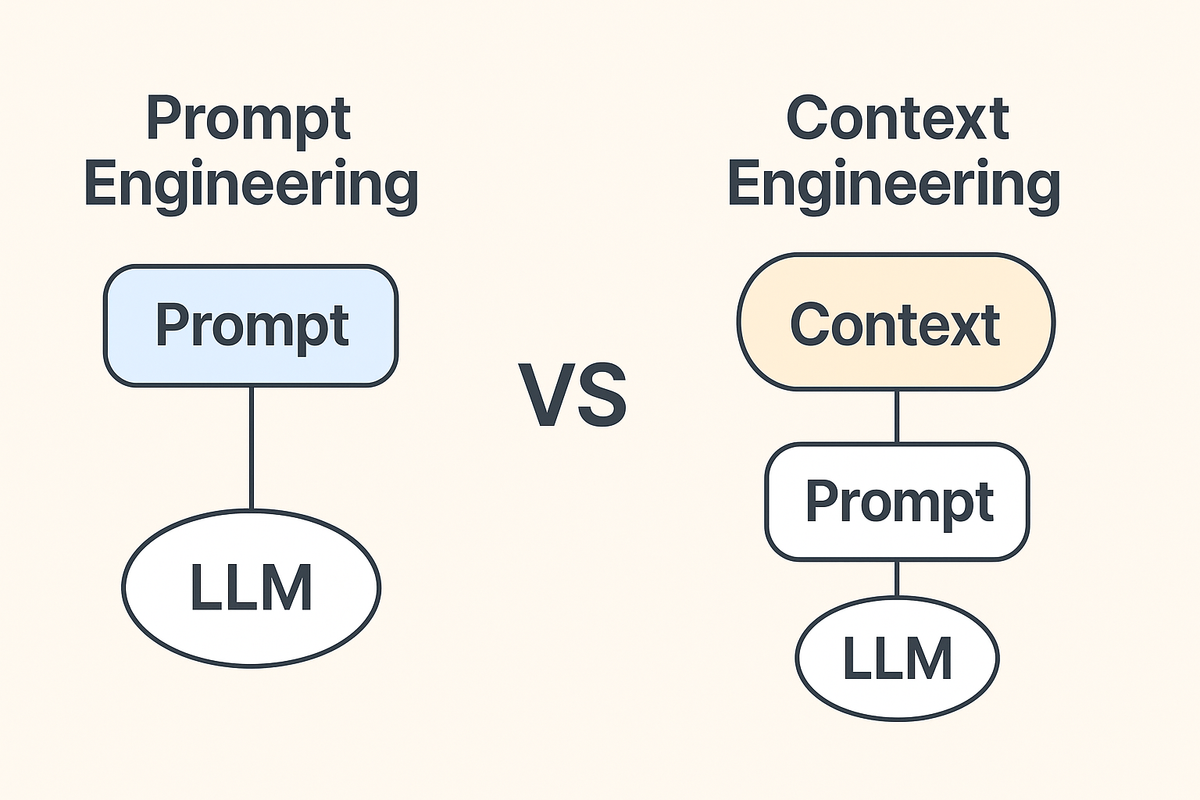Prompt Engineering vs Context Engineering
While prompt engineering is about what you say, context engineering is about what the AI knows before it interprets your request.

As artificial intelligence (AI) continues to evolve, two terms have become increasingly important in the world of Large Language Models (LLMs): Prompt Engineering and Context Engineering. While they may sound similar, they play very different roles in how we interact with and optimize the performance of AI systems like ChatGPT, Claude, Gemini, and others.
In this article, we'll explore:
- What is Prompt Engineering?
- What is Context Engineering?
- Key Differences Between Prompt Engineering and Context Engineering
- When to Use What?
- Real-World Examples
- Why These Concepts Matter in Modern AI Development
✅ What is Prompt Engineering?
Prompt Engineering is the art and science of crafting effective inputs (prompts) to get the desired output from an AI model.
Think of it like asking a smart assistant for help — the way you ask a question can heavily influence the answer you receive. A clear, well-structured prompt leads to better, more accurate results.
📌 Example:
"Write a professional summary for a software engineer with 5 years of experience in Python and AI."
Prompt Engineering Example
This prompt tells the LLM exactly what to do.
✅ What is Context Engineering?
Context Engineering, on the other hand, goes a step deeper. It focuses on shaping the entire environment in which the prompt is processed. This includes:
- Background knowledge
- User preferences
- System instructions
- Memory or ongoing conversation history
- Relevant documents or datasets
While prompt engineering is about what you say, context engineering is about what the AI knows before it interprets your request.
📌 Example:
If an AI assistant is helping a doctor with patient summaries, context engineering involves embedding:
- The patient’s medical history
- Recent lab results
- Specialty-specific terminology
This background data is injected into the LLM’s context window before the actual prompt is even sent.
🔄 Prompt Engineering vs Context Engineering:
| Feature | Prompt Engineering | Context Engineering |
|---|---|---|
| Purpose | Design effective prompts for desired output | Design the background knowledge for the LLM |
| Focus | The exact phrasing of user input | What the model knows when it receives the input |
| Tools Used | Natural language, templates | Vector databases, embeddings, system prompts |
| Data Scope | Current prompt only | Current + historical + external documents |
| Example Use Case | Writing better queries in ChatGPT | Building an AI chatbot with user-specific memory |
📦 When to Use Prompt vs Context Engineering
Use Prompt Engineering when:
- You're working with a one-off query or task.
- The input alone is sufficient for the model to generate a useful response.
- You are testing LLM behaviour for different prompt formats.
Use Context Engineering when:
- You need continuity in multi-turn conversations.
- You're designing an AI agent or tool that relies on prior knowledge.
- You're building enterprise AI systems that require private data or APIs.
🌐 Real-World Use Cases
🔸 Prompt Engineering in Action:
A marketer uses different prompt structures to generate ad copies and A/B test them with an LLM to see which tone converts best.
🔸 Context Engineering in Action:
A legal AI assistant is built that can summarize case law. Developers inject hundreds of past legal rulings and contracts using embeddings + vector search to provide context before prompting the model.
🚀 Why This Matters in Gen AI Development
As LLMs become central to AI product development, knowing how to interact with them efficiently becomes a competitive advantage. Relying on just prompt engineering can limit your use cases. Context engineering unlocks the power of retrieval, memory, and dynamic knowledge updates, allowing LLMs to become smarter, more relevant, and more personalized.
By combining both disciplines, you can:
- Improve response accuracy
- Reduce token usage
- Provide users with more personalized, enterprise-grade AI experiences
✅ Final Thoughts
Prompt Engineering is about how you ask.
Context Engineering is about what AI knows when you ask.
Both are essential components of building robust, intelligent, and context-aware AI systems in 2025 and beyond. Whether you’re building AI copilots, customer support agents, or internal knowledge tools — understanding the difference between prompt engineering and context engineering is a must.